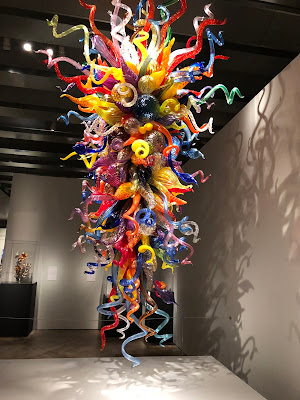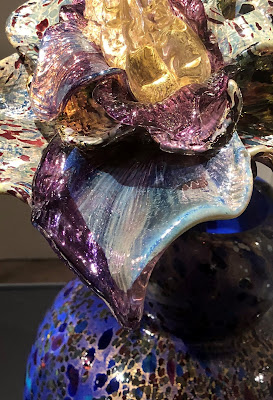I've long been a fan of Dale Chihuly's work, it seems like no matter where I go I can always stumble across an exhibition, or a piece hanging in an unexpected place. The museum's 90 foot cone shape is hard to miss as you drive into town.
The cone, inspired by the wood "beehive burners" of the sawmills that once dotted the waterway, is composed of 2,800 diamond-shaped stainless steel panels and the Hot Shop is inside.
Immediately upon taking my $15 entrance fee they encouraged me to go to the Hot Shop and watch. A gent was talking into a microphone the whole time describing the process. Quite a few folk sat there raptly listening. I was not one of them...I lasted a whole two minutes before i popped back up out of my seat. I don't need every detail of the artistic process explained to me, that takes all the fun out of it. Besides, my eyes kept straying to the word Glory Hole and I just couldn't keep a straight face after seeing that.
I was there to see the finished pieces, so on to the galleries. Surprisingly, not as much on display as I would have thought. I saw more pieces outside the museum than inside. The ones outside are free. There are also two other chandeliers similar to the one below in town that you can see for free.
It was a bit disappointing.
The second gallery had the work of Albert Paley which combined glass and steel. It was cool.
I mean, look at that! But, I felt it could have been better lit or displayed. Something about the presentation made it feel flat which it absolutely should not have.
Here's a longer view of the gallery. Anyone who knows anything about art out there who can help me express what I can't quite put my finger on? The setting just seemed all wrong for the pieces.
Even the glass didn't seem to be catching the light in a way that was appealing. I did love the lines of this one, it felt so art deco to me.
The most amusing part of my short tour was the special gallery featuring glass pieces made by children. This one was adorable. Even better was the long winded gentleman standing in front of it preventing me being able to view it no matter how many times I tried to peek around him. He patiently was explaining in excruciating detail to some lady what specifically he found enlightening about every aspect of the composition. Honestly, I kid you not.
As I mentioned, more glass is featured outside. A spiral staircase leads up around the cone to the Chihuly Bridge of Glass, a 500-foot-long pedestrian overpass that links the Museum to downtown Tacoma.
 |
| Venetian Wall and one of the Crystal Towers |
Closest to the Museum is the Venetian Wall, an eighty-foot installation displaying 109 sculptures from three of Chihuly's series: Venetians, Ikebana, and Putti. The Venetians are exuberant sculptures with origins in Venetian Art Deco glass. Ikebana are quiet pieces, created in the spirit of traditional Japanese floral arrangements. Putti were popular figures in European art of the sixteenth and seventeenth centuries and represent Cupid, the Roman god of love.
 |
| Crystal Towers toward rear of photo, Seaform Pavilion ceiling above |
Marking the center of the bridge are the Crystal Towers, which rise forty feet above the bridge deck and serve as beacons of light for the Chihuly Bridge of Glass bridge and city. Illuminated from below, the forms glow at night but I did not end up being able to go back and see them lit, unfortunately. The 63 large crystals in each tower are made from Polyvitro, a polyurethane material developed to withstand the elements and not made from glass.
I mean, Holy Seaforms, right? Easily 100 times the amount of glass pieces outside on the bridge than I saw inside the museum. The Seaform Pavilion is a ceiling made of 2,364 objects from Chihuly's Seaform and Persian series. Placed on top of a fifty-by-twenty-foot plate-glass ceiling, the forms are suspended in midair and I'm sure are amazing on a sunny day but as you can see from my photos it was quite cloudy so they did not photograph as well as I would have liked. There were also some reflecting pools at the entrance that looked downright gloomy and depressing at the time of my visit but that are also lit at night. If we had been staying closer to Tacoma I would have gone back at night just to look at all of this, but it wasn't worth fighting rush hour traffic. My suggestion is enjoy the free stuff, there is more of it around town and in the and unless you want to see how it is made skip paying the entrance fee. I also saw some nice pieces at the Tacoma Art Museum and the old Union Station both on the other side of the Glass Bridge which I will cover another day.












The inside looks as boring as the outside and just grim. Sounds like you came away feeling ripped off. The glass outside looked impressive
ReplyDeleteCool bridge! I'll take your advice and just visit the free stuff outside if I ever get up there.
ReplyDeleteThis can be quite academic location. They have well known knowledge in what When i shortage so that you can experience. Large declaring. This type of blare is often a well known shade so that you can apprehend so that you can events. Congrats employing a work well reached. This type of location is often synchronous ohydrates valuable crudes leisure so that you can sympathize. When i once-in-a-lifetime all you fine actually on this page. single tine digging tool
ReplyDelete